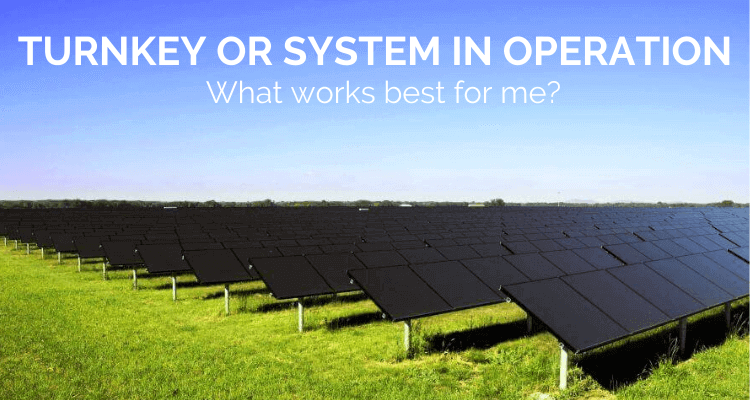Turnkey or System In Operation: Which Photovoltaic Investment Is Best?
Every investor who decides to invest in a commercial photovoltaic (PV) system contributes to the success of the energy transition. But when it comes to choosing which type of PV system they want to invest in, they will need to choose: do I acquire a brand new system (also called “turnkey” system), or do I get an existing one, already in operation?
Based on 3 characteristics, we will describe in this article the differences in the acquisition of each type of plant.
Explanation of terms
In order to better understand the differences between turnkey and existing plants, we will explain the terms in the first step:
A “turnkey” system is constructed so that it can be handed over to a buyer and can be directly connected to the grid – it is a project entirely completed.
An “existing plant” (or “already-operating”) is a constructed system that has already been connected to the grid for some time and is feeding electricity into it. It therefore already has a producing history.
1. Time of sale
Even though the term “turnkey” suggests that you will buy it key in hand straight away, it does not mean that the time of purchase must be at the end of the construction phase. These plants might be handed over “turnkey”, but the sale can take place at any stage of the project.
Indeed, it is not uncommon for the investor to help finance the construction of the PV system step by step by making partial payments on the purchase price. This is comparable to real estate development projects, which are to be paid in fixed tranches according to the progress of construction.
In the case of an existing plant, the purchase price is paid at a time defined in the purchase agreement during ongoing operation.
2. Opportunities versus risks
When investing in a turnkey plant, it is possible to take the investor’s wishes into account. This can then influence the components installed (modules and inverters) or, if applicable, the contractual arrangements with the lessor, the financing bank and the future service providers. This is virtually impossible in the case of existing plants, unless financing and service contracts do not have to be taken over at the time of purchase.
On the other hand, buyers of already-operating plants have no construction and grid connection risk, as is the case when investing in turnkey plants.
When payments have to be made according to the progress of construction, you must pay attention to securing these payments. These risks can be managed professionally and should be accompanied legally and technically by experienced partners.
In the case of an existing plant, its performance can be easily determined by evaluating historical yield data. A technical inspection before purchasing the plant helps to identify technical deficiencies that may lead to yield losses or repairs.
The future performance of a turnkey plant should be shown to the investor thanks to an expert yield report. A professional construction inspection of the connected PV system provides the certainty that the predicted yields can also be achieved in the future.
However, the history of an existing plant can also lead to risks in the case of a share deal (takeover of the operating company), since the risk of unrecognized defects from the past is always acquired along with it (audit risk). In the case of a turnkey plant without a history, this risk is largely eliminated.
A significant advantage of turnkey plants is the currently very favourable financing conditions. Indeed, existing plants have older, expensive financing arrangements that often have to be taken over or redeemed in return for early repayment penalties. For turnkey systems, new financing is available, at the current historically low interest rates.
3. Return expectations
The final question is of course the return on investment.
Here, there should be no difference between existing and turnkey plants. For both plants, the return is based on the capitalized earnings value, which is calculated from the discounted earnings of the remaining years of remuneration.
This means that the respective acquisition costs are offset by the current remuneration on the electricity fed into the grid, the remaining term of the remuneration, and the ongoing costs of operating the PV system.
For a PV system in operation that has been connected to the grid for several years, the remuneration rate will be higher than for a turnkey plant, but its remaining term is shorter.
The pricing of opportunities and risks is decisive for the price and thus the return. Here, it is important to prepare the price negotiations well.
Conclusion
In the end, we see that investments in commercial PV systems – whether turnkey or in operation– involve opportunities and risks that every investor should be aware of.
The challenge is to make good use of the opportunities while managing the risks with the help of professional service providers. There should be no difference in returns, assuming that any risks are fairly priced.
Unfortunately, it is likely that the supply of turnkey plants will decrease significantly due to the size limits in the new EEG2021. Investors are more likely to be faced with the question “do I buy what is currently available on the market?” instead of deciding if they should invest in a turnkey or in an already-operating system.
If you are an investor who wants to make a contribution to the energy transition, can find a large offer of photovoltaic systems on our PV marketplace – turnkey, already-operating, project rights: the choice is yours.
This is a free translation. To read the original article in German: click here.





